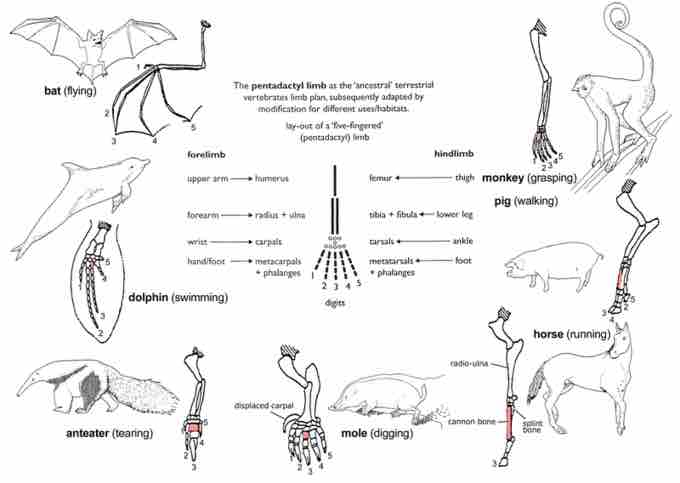Homologous Structures
Homology is the relationship between structures or DNA derived from the most recent common ancestor. A common example of homologous structures in evolutionary biology are the wings of bats and the arms of primates. Although these two structures do not look similar or have the same function, genetically, they come from the same structure of the last common ancestor. Homologous traits of organisms are therefore explained by descent from a common ancestor.
It's important to note that defining two structures as homologous depends on what ancestor is being described as the common ancestor. If we go all the way back to the beginning of life, all structures are homologous!

Homology in the forelimbs of vertebrates
The principle of homology illustrated by the adaptive radiation of the forelimb of mammals. All conform to the basic pentadactyl pattern but are modified for different usages. The third metacarpal is shaded throughout; the shoulder is crossed-hatched.
In genetics, homology is measured by comparing protein or DNA sequences. Homologous gene sequences share a high similarity, supporting the hypothesis that they share a common ancestor.
Homology can also be partial: new structures can evolve through the combination of developmental pathways or parts of them. As a result, hybrid or mosaic structures can evolve that exhibit partial homologies. For example, certain compound leaves of flowering plants are partially homologous both to leaves and shoots because they combine some traits of leaves and some of shoots.
Paralogous Structures
Homologous sequences are considered paralogous if they were separated by a gene duplication event; if a gene in an organism is duplicated to occupy two different positions in the same genome, then the two copies are paralogous.
A set of sequences that are paralogous are called paralogs of each other. Paralogs typically have the same or similar function, but sometimes do not. It is considered that due to lack of the original selective pressure upon one copy of the duplicated gene, this copy is free to mutate and acquire new functions.
Paralogous genes often belong to the same species, but not always. For example, the hemoglobin gene of humans and the myoglobin gene of chimpanzees are considered paralogs. This is a common problem in bioinformatics; when genomes of different species have been sequenced and homologous genes have been found, one can not immediately conclude that these genes have the same or similar function, as they could be paralogs whose function has diverged.
Analogous Structures
The opposite of homologous structures are analogous structures, which are physically similar structures between two taxa that evolved separately (rather than being present in the last common ancestor). Bat wings and bird wings evolved independently and are considered analogous structures. Genetically, a bat wing and a bird wing have very little in common; the last common ancestor of bats and birds did not have wings like either bats or birds. Wings evolved independently in each lineage after diverging from ancestors with forelimbs that were not used as wings (terrestrial mammals and theropod dinosaurs, respectively).
Homology vs. analogy
The wings of pterosaurs (1), bats (2), and birds (3) are analogous as wings, but homologous as forelimbs. This is because they are similar characteristically and even functionally, but evolved from different ancestral roots.
It is important to distinguish between different hierarchical levels of homology in order to make informative biological comparisons. In the above example, the bird and bat wings are analogous as wings, but homologous as forelimbs because the organ served as a forearm (not a wing) in the last common ancestor of tetrapods.
Analogy is different than homology. Although analogous characteristics are superficially similar, they are not homologous because they are phylogenetically independent. The wings of a maple seed and the wings of an albatross are analogous but not homologous (they both allow the organism to travel on the wind, but they didn't both develop from the same structure). Analogy is commonly also referred to as homoplasy.